What’s a sales process?
Your sales process should include all the stages you and your customer need to go through, from the first contact until the actual sale. You must be crystal clear about your sales process. You must own it! Never make the mistake of assuming your customer knows what the next sales step is. You must take the lead and guide your customer forward. When neither of you know what the next step is, it’s like the blind leading the blind. You’ll find yourself going round and round in circles without getting anywhere. Every little activity is an important part of your sales process. It’s on that foundation that you can build an even and steady flow of sales.
What does a sales process look like?
Traditionally, the sales process has been different for consumer products and B2B transactions. However, sales to businesses and consumers are now getting increasingly more similar.
Review the whole business process and note your sales activities. Start with prospecting, data input and sales targets. Once you understand what the customer needs, you can move on to structure the offer and prepare a proposal.
However, it’s not only what you sell that has an impact on your sales process. The key to successful sales is to build strong relationships. Not only with the customer as a business, but with every individual person.
So, how do you do that? The activity ladder is a good starting point.
The activity ladder – pipeline management from prospecting to order
The activity ladder is a common model for a linear approach to the sales process. For every contact you have with the customer you move one step further up the ladder. As you do this, you also build your trust capital and deepen your understanding for the customer and their business.
The activity ladder represents your sales pipe – with all the steps you need to take to turn a prospect into a customer.
Your first task is to find the right customers, or what in sales is referred to as prospecting. Here it’s key to strike gold – your ideal customer whose needs match what you can offer.
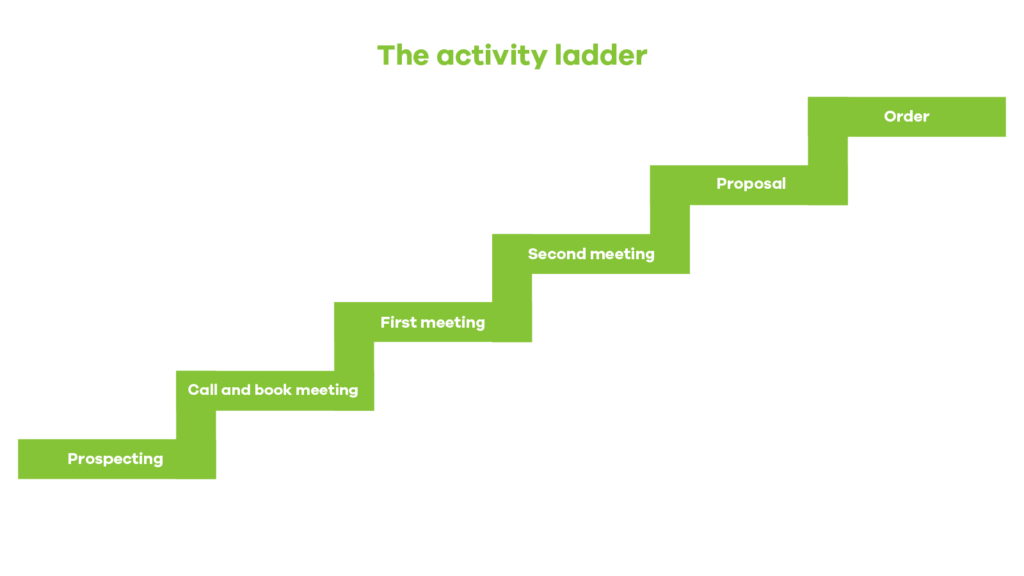
Once you have found a potential customer it’s time to book the first meeting. More often than not, you’ll need to have two sales meetings before you can submit a proposal. You need to come prepared, so make sure to do sufficient research on the customer prior to these meetings.
Have a really good look to make sure you prepare a proposal that truly meets your customer’s needs. This is the last stage that will take you to the very top of the ladder – an order.
How do you move from one step to another? Follow our seven best tips for a successful sales process!
7 steps to a successful sales process
Anyone who has worked in sales knows how hard it can be to get a good balance between prospecting, customer meetings and to actually closing deals.
Do you wish your sales process was designed to help you bring in a steady and even flow of sales?
Follow our seven simple steps to design a successful sales process within your business. We start by zooming in on the actual business process.
Don’t have time to read everything right now?

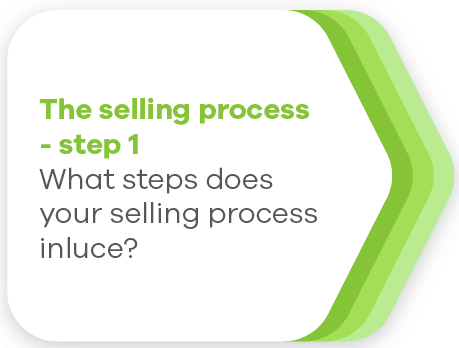
1. What steps do your sales cycle consist of?
Some companies sell physical products, whilst others sell services. Some companies do deals for millions, and others for thousands. You get the gist – companies are just different. That’s why the sales processes are different too.
The first step towards a more structured sales process is to map out the different steps in your particular business process – i.e. your sales cycle from start to finish.
Most likely, your daily sales activities include things like prospecting, sales calls, customer visits, proposals and signing sales contracts. It’s also likely that you and others in your sales team need to make two or more customer visits to win a contract.
Spend some time thinking about which sales steps you need to go through, from start to finish. Structure your own activity ladder. Once you’ve identified all the activities, move on to the next topic: What’s your hit rate?
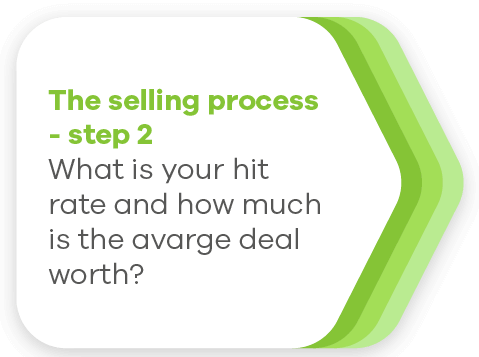
2. What’s your hit rate and what’s your average deal worth?
Selling without knowing your hit rate has failure written all over it – you’re simply hoping for miracles without having done your homework. To be successful you need to know what works.
Working out your hit rate is an insightful process. Not only can you find out how many proposals you’ve submitted, you also get a good understanding of how much time you spend on this activity.
How often are you able to move forward in your sales cycle? Work out what percentage of the total number of activities move you forward to the next step in the activity ladder:
- How many prospecting activities lead to booked meetings?
- How many booked meetings lead to actual sales discussion?
- How many sales discussions lead to submitted proposals?
Divide the total number of meetings by the total number of submitted proposals, and do the same for each step in the ladder. Work out the numbers for each step in the activity ladder.
For example: If four prospecting activities lead to an average of one meeting then your hit rate is 25%.
Having access to a CRM tool makes it easy to work out these numbers. Your CRM system can help you work out what the average signed deal is worth.
You obviously want to know what an average deal is worth. You do that by dividing the total sales value for the last 12 months by the total number of deals signed in the same period.
Total sales: £247,250
Number of signed deals: 215
247,250 (sales value)/215 (number of signed deals) = £1,150 per deal (average value)
That wasn’t hard! Now you know both your hit rate and how much your average deal is worth.
But how do you know that these results will be the same over time? Proceed to step three to find out what you need to achieve on a daily basis to meet your sales target.
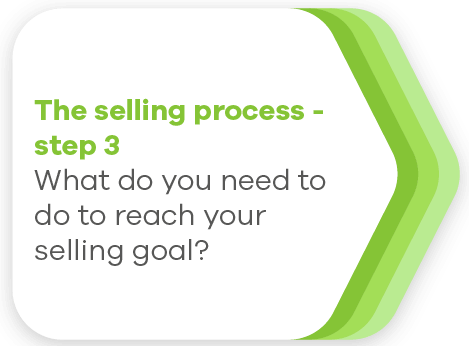
3. What do you need to do to achieve your sales target?
The third step in structuring a successful sales process is to break down your sales target and activity ladder into months, weeks and/or days.
You need to work out how many activities you need to carry out to meet your sales targets. Most salespeople have a clearly defined sales target. We are using the target number and the value of your average deal (apply your own numbers here):
- Your sales target for the whole year is £150,000
- Your average deal is worth £7,500
In this example you need to close 20 deals during the year.
Apply your hit rate to work out what you need to do
Let’s assume your hit rate is 50% between each step in the activity ladder.
To close 20 deals you need to submit 40 proposals. You need to have 80 follow-up visits, 160 first-time visits, make 320 calls to book meetings and have contact details to 640 potential customers. During an entire year.
So, what do you need to do next week?
Your new schedule week by week
Let’s simplify it even further. Let’s assume you work 40 full weeks in the year. This makes it easy to see what you need to keep an eye on to ensure you don’t lag behind on your sales target.
To achieve your sales target of £150,000, you must each week:
- Submit one proposal
- Make two follow-up visits
- Make four first-time visits
- Make 8 calls to book meetings
- Find 16 new prospects
Breaking down the target makes it easier to focus on value-adding activities. With a structured sales process you always have instant control of what you need to achieve to smash your sales target.
Now that you have a plan, let’s start where every new business opportunity begins: Prospecting for new customers.
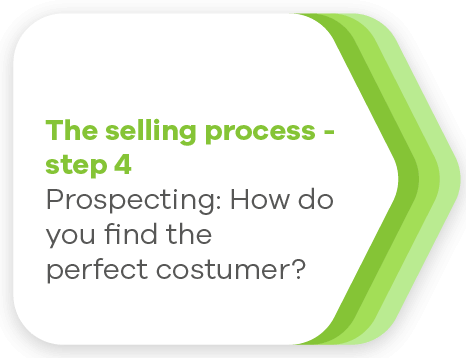
4. Prospecting: How to find the right customer
What does your business add for the customer? As an experienced salesperson you’re probably on top of this, but if you’re unsure – find out!
Smart prospecting saves you a lot of time. Start by understanding who your ideal customer is. This is about finding a match between what the customer needs and what you can offer. The ideal customer is hard to find in a group of potential customers. It’s the target group that you’re most likely to close deals with.
Some businesses divide their prospects into industries or company sizes (e.g. number of employees). But two customers from the same industry don’t necessarily need the same thing. Only you know how your business can best go about segmenting your customer base.
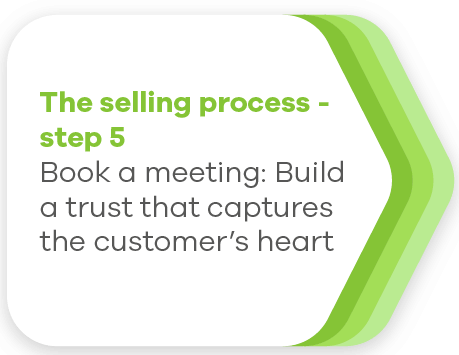
5. Booking meetings: Build trust that touches the customer’s heart
The best way to book good meetings? Credibility, timing and commitment. Your first contact has to touch the customer’s heart. And you need to do it within seconds. To succeed, this step requires a certain level of commitment from you.
A good salesperson is a good listener. Your chances for a good conversation increase if you use similar language and are on the same wavelength as the customer. Understanding is an important component in all relationships.
Cold calling is draining. You have to catch the interest of someone that doesn’t know you. Making a call and speaking from a script doesn’t work. Instead, think of the customer as a new friend. What’s the person interested in?
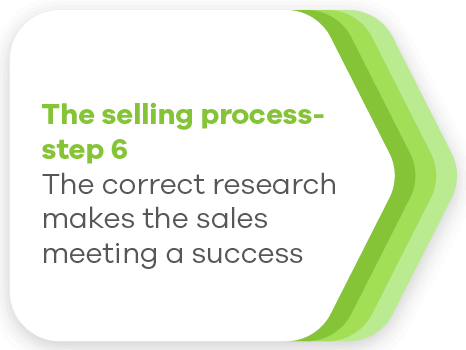
6. With the right research the customer meeting will be a hit
To build long-term relationships you must have credibility. Customers like you when you demonstrate that you understand them. And those are the [lt_wpml_page_url id=”62493″ post_type=”article” ]characteristics of the best sales people – making good relationships with customers that trust you.
At this stage it’s a good idea to find out what’s going on in the customer’s organisation. Particularly if there seems to be a lot happening. Take a look at your notes from the first meeting to understand:
- What does the customer need?
- What challenges are they facing and how can you best help them with a solution?
- What terminology and expressions does the customer use?
To build trust, you need to get as close to the core of the customer’s needs as possible. Step into the customer’s everyday and tell them how your service or product will solve their issues.
- Have they moved office?
- Have they recently been through an IPO?
- Have they perhaps been recognised with an award for best sales department?
By paying attention to events like that, you demonstrate that you understand the customer’s business and the situation they currently find themselves in. Your offer must be a solution to the customer’s problem.
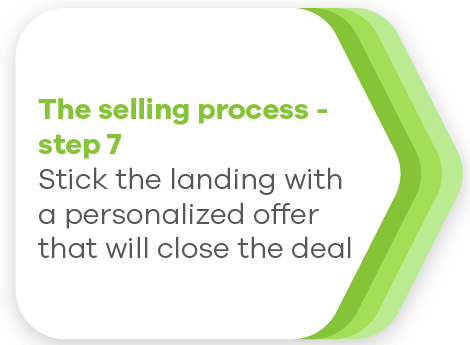
7. Finish on a high with a personal proposal that seals the deal
Some B2B sales processes are long, up to several years, which requires a generous dose of patience to keep the customer warm. At the same time, you mustn’t nag them.
We know what it’s like. It’s tempting to start talking about the product the further up the activity ladder you get. Avoid that. Instead, listen to the customer and come up with attractive solutions. When the customer feels like you actually have a solution, it’s going to be a lot easier to close the deal.
Sometimes the customer may need some sort of incentive to progress through the sales cycle towards a decision. This is when it might work wonders to extend a special offer or a discount when you hand in the proposal.
Also bear in mind that the way the proposal is presented and delivered and what method you use for signing (e-signing is recommended) affects how easy it is for the customer to accept the proposal. A straight forward presentation and hassle-free digital signing makes it so much easier for you to close the deal.
With the help of a CPQ addon for your CRM system you can easily create stylish and selling sales quotes. CPQ is short for Configure Price Quote and is a system solution used to easily generate complete sales quotes. With a CPQ in place you save time when creating sales quotes and can be assured they’ll always look the way you intended. With Lime CRM and Lime CPQ you get a complete system that helps you become a more efficient sales person, so you can focus on closing more deals instead of doing administrative tasks.
Are you getting more happy customers?
A sales rep’s performance is often measured month by month, or at other intervals during the year. By following the development of your sales process, and how you perform against your sales target, you will soon learn to determine what actions are required at certain points in time.
But what happens now to your new (and most likely very happy) customer?
If everything goes to plan, you can let the customer move forward through the customer journey, in the safe hands of your colleagues. But it’s silly to risk it. Whether the customer stays loyal to you or moves to another supplier depends on their level of satisfaction.
Always ensure the customer:
- Gets started with the service properly and as planned.
- Understands the contract and whether they need to take an active decision to continue using the service.
- Is kept engaged with marketing activities such as practical information, newsletters or other communication via various types of services, the customer service team or via social media platforms.
A CRM system for smarter sales processes
It’s possible, of course, to have a structured sales process without a CRM. However, having a CRM system adapted to your sales team’s needs means everything is so much more streamlined and simple. Lime CRM offers tools for more effective sales processes. Developed by salespeople, for salespeople.
Lime CRM Sales includes the following:
- Access to information about your customers and your business opportunities – in one place.
- A structured sales process that guides you from a lead to a signed deal.
- Less administration and time saved thanks to integrations with your ERP system, credit checks and email client.
- Visual dashboards and individual KPIs for easier follow-up and reporting.
- Proposal templates and reminders that help you close deals faster.
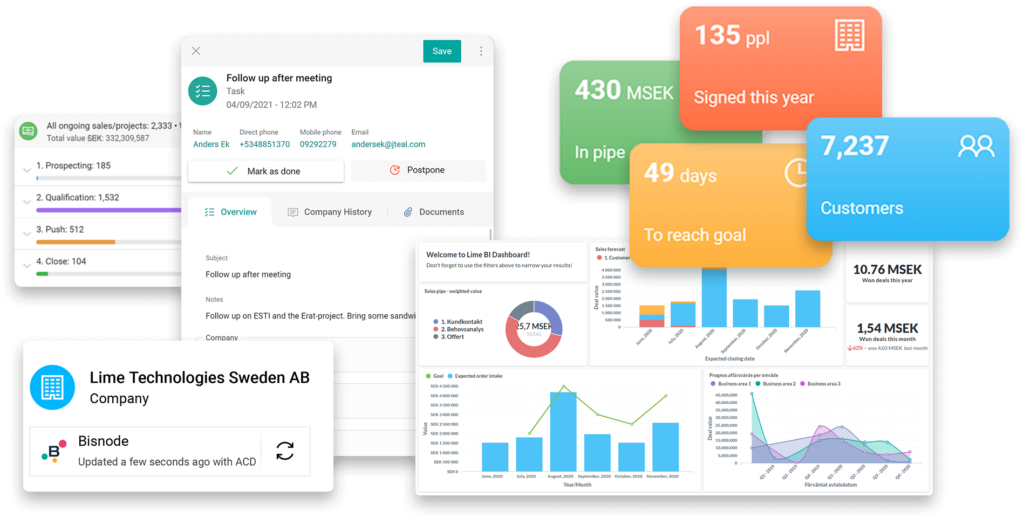
What are you waiting for?
There’s no time to waste! Let’s find the solution that will help you get more customers and turn existing ones into loyal ambassadors today.


